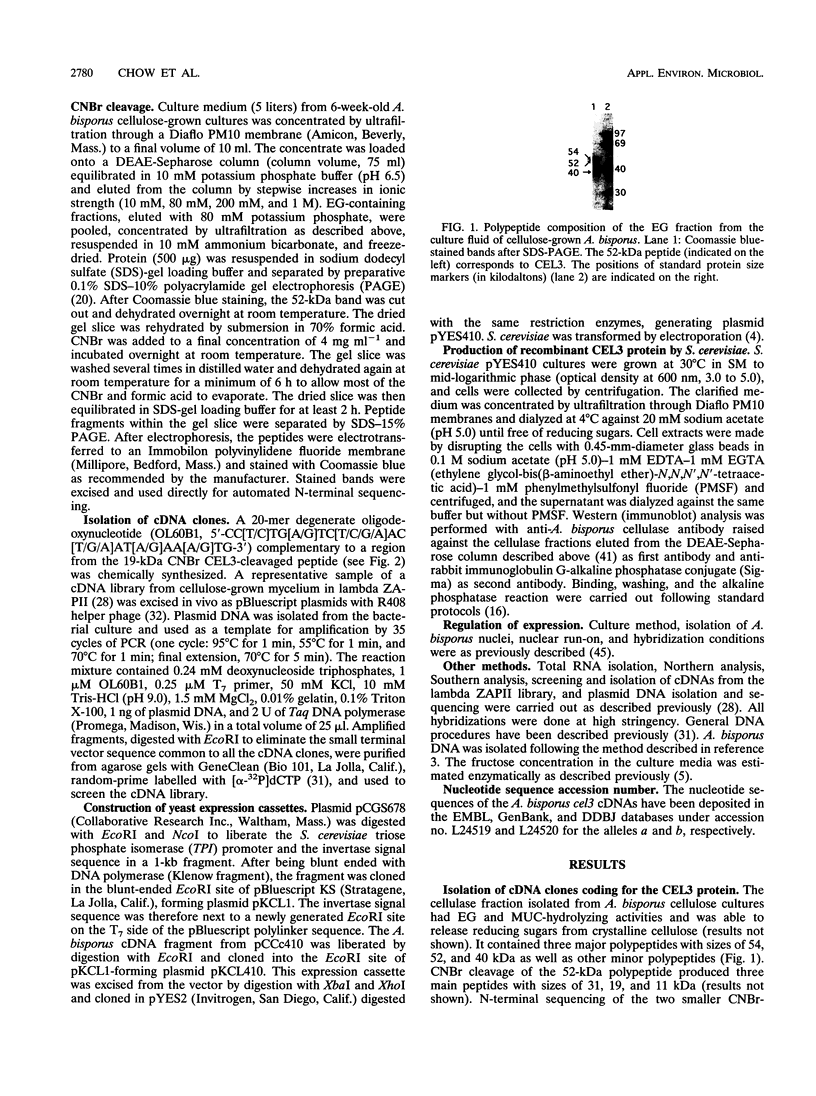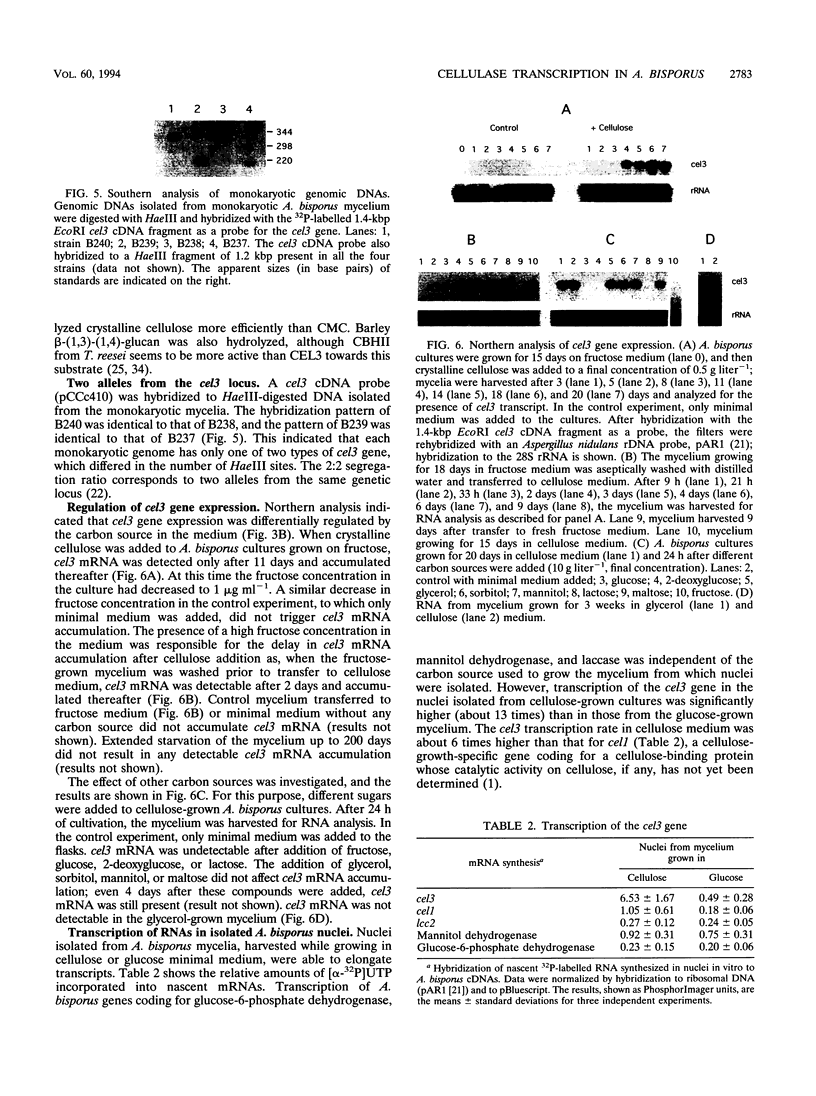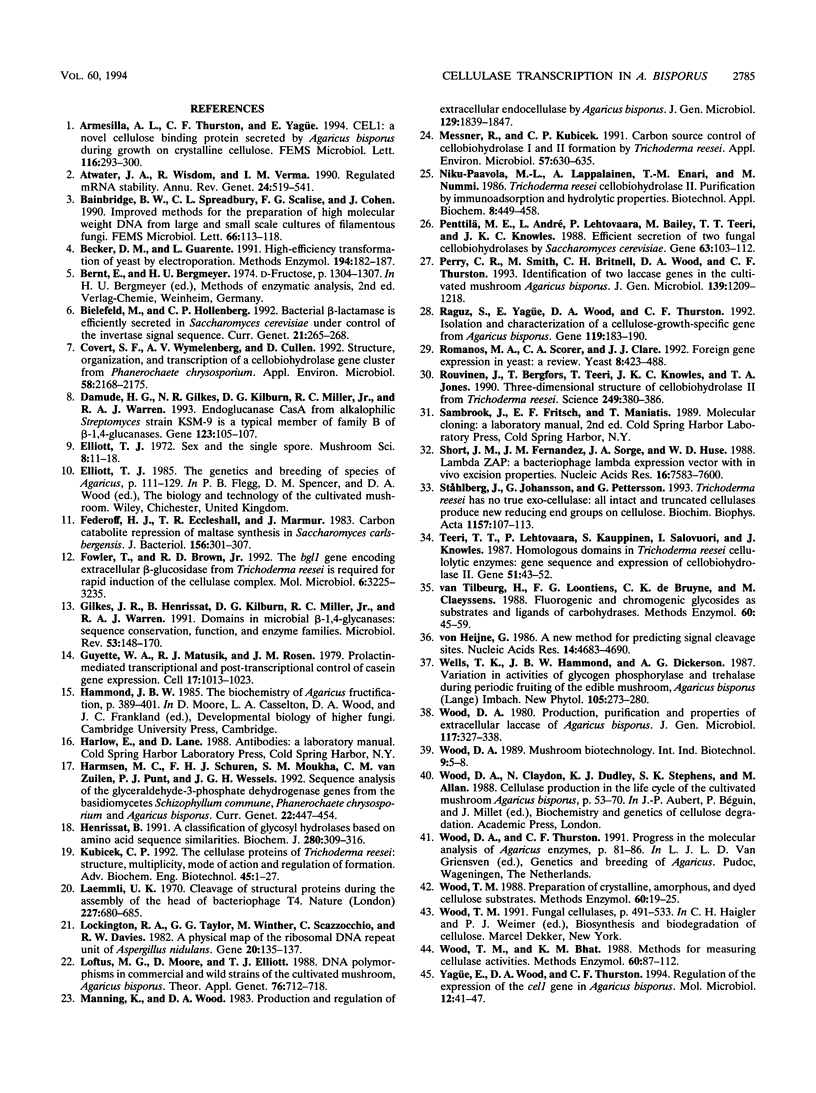Abstract
A 52-kDa protein, CEL3, has been separated from the culture filtrate of Agaricus bisporus during growth on cellulose. A PCR-derived probe was made, with a degenerate oligodeoxynucleotide derived from the amino acid sequence of a CEL3 CNBr cleavage product and was used to select cel3 cDNA clones from an A. bisporus cDNA library. Two allelic cDNAs were isolated. They showed 98.8% identity of their nucleotide sequences. The deduced amino acid sequence and domain architecture of CEL3 showed a high degree of similarity to those of cellobiohydrolase II of Trichoderma reesei. Functional expression of cel3 cDNA in Saccharomyces cerevisiae was achieved by placing it under the control of a constitutive promoter and fusing it to the yeast invertase signal sequence. Recombinant CEL3 secreted by yeast showed enzymatic activity towards crystalline cellulose. At long reaction times, CEL3 was also able to degrade carboxymethyl cellulose. Northern (RNA) analysis showed that cel3 gene expression was induced by cellulose and repressed by glucose, fructose, 2-deoxyglucose, and lactose. Glycerol, mannitol, sorbitol, and maltose were neutral carbon sources. Nuclear run-on analysis showed that the rate of synthesis of cel3 mRNA in cellulose-grown cultures was 13 times higher than that in glucose-grown cultures. A low basal rate of cel3 mRNA synthesis was observed in the nuclei isolated from glucose-grown mycelia.
Full text
PDF






Images in this article
Selected References
These references are in PubMed. This may not be the complete list of references from this article.
- Armesilla A. L., Thurston C. F., Yagüe E. CEL1: a novel cellulose binding protein secreted by Agaricus bisporus during growth on crystalline cellulose. FEMS Microbiol Lett. 1994 Mar 1;116(3):293–299. doi: 10.1111/j.1574-6968.1994.tb06718.x. [DOI] [PubMed] [Google Scholar]
- Atwater J. A., Wisdom R., Verma I. M. Regulated mRNA stability. Annu Rev Genet. 1990;24:519–541. doi: 10.1146/annurev.ge.24.120190.002511. [DOI] [PubMed] [Google Scholar]
- Bainbridge B. W., Spreadbury C. L., Scalise F. G., Cohen J. Improved methods for the preparation of high molecular weight DNA from large and small scale cultures of filamentous fungi. FEMS Microbiol Lett. 1990 Jan 1;54(1-3):113–117. doi: 10.1016/0378-1097(90)90267-t. [DOI] [PubMed] [Google Scholar]
- Becker D. M., Guarente L. High-efficiency transformation of yeast by electroporation. Methods Enzymol. 1991;194:182–187. doi: 10.1016/0076-6879(91)94015-5. [DOI] [PubMed] [Google Scholar]
- Bielefeld M., Hollenberg C. P. Bacterial beta-lactamase is efficiently secreted in Saccharomyces cerevisiae under control of the invertase signal sequence. Curr Genet. 1992 Apr;21(4-5):265–268. doi: 10.1007/BF00351680. [DOI] [PubMed] [Google Scholar]
- Covert S. F., Vanden Wymelenberg A., Cullen D. Structure, organization, and transcription of a cellobiohydrolase gene cluster from Phanerochaete chrysosporium. Appl Environ Microbiol. 1992 Jul;58(7):2168–2175. doi: 10.1128/aem.58.7.2168-2175.1992. [DOI] [PMC free article] [PubMed] [Google Scholar]
- Damude H. G., Gilkes N. R., Kilburn D. G., Miller R. C., Jr, Warren R. A. Endoglucanase CasA from alkalophilic Streptomyces strain KSM-9 is a typical member of family B of beta-1,4-glucanases. Gene. 1993 Jan 15;123(1):105–107. doi: 10.1016/0378-1119(93)90547-g. [DOI] [PubMed] [Google Scholar]
- Federoff H. J., Eccleshall T. R., Marmur J. Carbon catabolite repression of maltase synthesis in Saccharomyces carlsbergensis. J Bacteriol. 1983 Oct;156(1):301–307. doi: 10.1128/jb.156.1.301-307.1983. [DOI] [PMC free article] [PubMed] [Google Scholar]
- Fowler T., Brown R. D., Jr The bgl1 gene encoding extracellular beta-glucosidase from Trichoderma reesei is required for rapid induction of the cellulase complex. Mol Microbiol. 1992 Nov;6(21):3225–3235. doi: 10.1111/j.1365-2958.1992.tb01777.x. [DOI] [PubMed] [Google Scholar]
- Guyette W. A., Matusik R. J., Rosen J. M. Prolactin-mediated transcriptional and post-transcriptional control of casein gene expression. Cell. 1979 Aug;17(4):1013–1023. doi: 10.1016/0092-8674(79)90340-4. [DOI] [PubMed] [Google Scholar]
- Harmsen M. C., Schuren F. H., Moukha S. M., van Zuilen C. M., Punt P. J., Wessels J. G. Sequence analysis of the glyceraldehyde-3-phosphate dehydrogenase genes from the basidiomycetes Schizophyllum commune, Phanerochaete chrysosporium and Agaricus bisporus. Curr Genet. 1992 Dec;22(6):447–454. doi: 10.1007/BF00326409. [DOI] [PubMed] [Google Scholar]
- Henrissat B. A classification of glycosyl hydrolases based on amino acid sequence similarities. Biochem J. 1991 Dec 1;280(Pt 2):309–316. doi: 10.1042/bj2800309. [DOI] [PMC free article] [PubMed] [Google Scholar]
- Laemmli U. K. Cleavage of structural proteins during the assembly of the head of bacteriophage T4. Nature. 1970 Aug 15;227(5259):680–685. doi: 10.1038/227680a0. [DOI] [PubMed] [Google Scholar]
- Lockington R. A., Taylor G. G., Winther M., Scazzocchio C., Davies R. W. A physical map of the ribosomal DNA repeat unit of Aspergillus nidulans. Gene. 1982 Dec;20(2):135–137. doi: 10.1016/0378-1119(82)90031-2. [DOI] [PubMed] [Google Scholar]
- Messner R., Kubicek C. P. Carbon Source Control of Cellobiohydrolase I and II Formation by Trichoderma reesei. Appl Environ Microbiol. 1991 Mar;57(3):630–635. doi: 10.1128/aem.57.3.630-635.1991. [DOI] [PMC free article] [PubMed] [Google Scholar]
- Penttilä M. E., André L., Lehtovaara P., Bailey M., Teeri T. T., Knowles J. K. Efficient secretion of two fungal cellobiohydrolases by Saccharomyces cerevisiae. Gene. 1988;63(1):103–112. doi: 10.1016/0378-1119(88)90549-5. [DOI] [PubMed] [Google Scholar]
- Perry C. R., Smith M., Britnell C. H., Wood D. A., Thurston C. F. Identification of two laccase genes in the cultivated mushroom Agaricus bisporus. J Gen Microbiol. 1993 Jun;139(Pt 6):1209–1218. doi: 10.1099/00221287-139-6-1209. [DOI] [PubMed] [Google Scholar]
- Raguz S., Yagüe E., Wood D. A., Thurston C. F. Isolation and characterization of a cellulose-growth-specific gene from Agaricus bisporus. Gene. 1992 Oct 1;119(2):183–190. doi: 10.1016/0378-1119(92)90270-y. [DOI] [PubMed] [Google Scholar]
- Romanos M. A., Scorer C. A., Clare J. J. Foreign gene expression in yeast: a review. Yeast. 1992 Jun;8(6):423–488. doi: 10.1002/yea.320080602. [DOI] [PubMed] [Google Scholar]
- Rouvinen J., Bergfors T., Teeri T., Knowles J. K., Jones T. A. Three-dimensional structure of cellobiohydrolase II from Trichoderma reesei. Science. 1990 Jul 27;249(4967):380–386. doi: 10.1126/science.2377893. [DOI] [PubMed] [Google Scholar]
- Short J. M., Fernandez J. M., Sorge J. A., Huse W. D. Lambda ZAP: a bacteriophage lambda expression vector with in vivo excision properties. Nucleic Acids Res. 1988 Aug 11;16(15):7583–7600. doi: 10.1093/nar/16.15.7583. [DOI] [PMC free article] [PubMed] [Google Scholar]
- Ståhlberg J., Johansson G., Pettersson G. Trichoderma reesei has no true exo-cellulase: all intact and truncated cellulases produce new reducing end groups on cellulose. Biochim Biophys Acta. 1993 May 7;1157(1):107–113. doi: 10.1016/0304-4165(93)90085-m. [DOI] [PubMed] [Google Scholar]
- Teeri T. T., Lehtovaara P., Kauppinen S., Salovuori I., Knowles J. Homologous domains in Trichoderma reesei cellulolytic enzymes: gene sequence and expression of cellobiohydrolase II. Gene. 1987;51(1):43–52. doi: 10.1016/0378-1119(87)90472-0. [DOI] [PubMed] [Google Scholar]
- Traynor O. J., Costa N. L., Wood C. B. A scanning electron microscopy study of changes in the colonic mucus layer during chemical carcinogenesis. Cancer. 1983 May 15;51(10):1847–1853. doi: 10.1002/1097-0142(19830515)51:10<1847::aid-cncr2820511016>3.0.co;2-4. [DOI] [PubMed] [Google Scholar]
- Yagüe E., Wood D. A., Thurston C. F. Regulation of transcription of the cel1 gene in Agaricus bisporus. Mol Microbiol. 1994 Apr;12(1):41–47. doi: 10.1111/j.1365-2958.1994.tb00993.x. [DOI] [PubMed] [Google Scholar]
- von Heijne G. A new method for predicting signal sequence cleavage sites. Nucleic Acids Res. 1986 Jun 11;14(11):4683–4690. doi: 10.1093/nar/14.11.4683. [DOI] [PMC free article] [PubMed] [Google Scholar]







